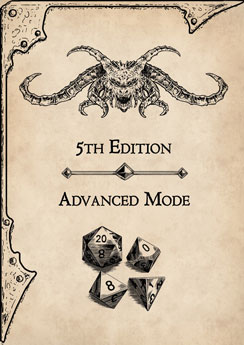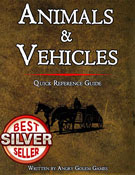Large monstrosity, unaligned
Armor Class 11
Hit Points 19 (3d10+3)
Speed 40 ft, fly 60 ft. (suggested fly 80 ft.)
Proficiency Bonus +2
Proficiency Bonus +2 (5th Edition Advanced Mode)
| STR | DEX | CON | INT | WIS | CHA |
|---|---|---|---|---|---|
| 17 (+3) | 13 (+1) | 13 (+1) | 2 (-4) | 12 (+1) | 8 (-1) |
Skills Perception +5
Senses passive Perception 15
Challenge 1 (200 XP)
Dive Attack (suggested). The hippogriff can perform a dive attack if it attacks from a height of 100 feet at least. While doing so, the hippogriff gains advantage with both claw attacks and inflicts double damage.
Grab on the Fly (suggested). If the hippogriff succeeds in at least one talon attack while performing the Dive Attack, then a target of Small or smaller size is automatically grappled and the hippogriff can make one attack with its beak with advantage. The next round, the target may attempt to escape the grapple (escape DC 8) or can attack the hippogriff with disadvantage. The hippogriff can release the grapple at any moment and have the target suffers appropriate fall damage.
Keen Sight. The hippogriff has advantage on Wisdom (Perception) checks that rely on sight.
ACTIONS
- Multiattack. The hippogriff makes three attacks: one with its beak and one with its claws.
- Multiattack (suggested). The hippogriff makes three attacks: one with its beak and two with its claws.
- Beak. Melee Weapon Attack: +5 to hit, reach 5 ft., one target. Hit: 8 (1d10 + 3) piercing damage.
- Claws. Melee Weapon Attack: +5 to hit, reach 5 ft., one target. Hit: 10 (2d6 + 3) slashing damage.
- Claws (suggested). Melee Weapon Attack: +5 to hit, reach 5 ft., one target. Hit: 6 (1d6 + 3) slashing damage.
5th Edition Advanced Mode
Limiting the power of a character and making the overall difficulty of the game harder, does not reduce the creativity, indeed it does quite the opposite.
The Game Master has the option to use any and all of the instances proposed in this guide, or just some of them according to their preference.
It is the lack of something that move and motivate characters, not the abundance of it
DESCRIPTION
A hippogriff is a magical creature that combines the features of an eagle and a horse. It has the wings, head, and forelegs of an eagle, and the body, hind legs, and tail of a horse. Its feathers and fur can vary in color, but are usually brown, black, or white. A typical hippogriff is 9 feet long, has a wingspan of 20 feet, and weighs 1,000 pounds.
Hippogriffs are related to griffons, but are less intelligent and more aggressive. They are also more adaptable to different environments, and can be found in grasslands, hills, mountains, and even deserts. Hippogriffs are voracious omnivores, and will hunt any prey they can catch, including humanoids. They are also fiercely territorial, and will attack any intruders that enter their domain.
Hippogriffs have a simple language of screeches, squawks, and whistles that they use to communicate with each other. They can also understand some basic commands from their riders or trainers. Hippogriffs are not very sociable with other creatures, except for horses and eagles, which they sometimes befriend or mate with. Hippogriffs have a natural enmity with griffons, which they see as rivals and enemies.
Hippogriffs are magical creatures that were created by ancient wizards who experimented with crossbreeding different animals. The exact origin of hippogriffs is unknown, but some legends suggest that they were first created in Persia or Greece. Hippogriffs are considered symbols of courage, nobility, and freedom by some cultures, while others view them as monsters or pests.
COMBAT
Hippogriffs are fast and powerful flyers, and prefer to dive at their prey from above. They use their keen sight to spot potential targets, and have advantage on perception checks that rely on sight. They make two attacks: one with their beak and one with their claws. Their beak can pierce through armor and flesh, while their claws can slash and rend their foes. Hippogriffs are not afraid to fight to the death, and will not retreat unless severely wounded or outnumbered.
Hippogriffs can be tamed by skilled trainers, who must first earn their respect by bowing to them and avoiding eye contact. Once a hippogriff accepts a rider, it will form a strong bond with them and obey their commands. Hippogriffs make excellent mounts for adventurers who need to travel long distances or explore dangerous terrains. However, they require a lot of care and food, and can be temperamental and stubborn at times.
Hippogriffs have difficulty breeding in captivity. Like flying, the wild hippogriff has to be captured before such skills are learned. Mature hippogriffs may be persuaded to voluntarily assist riders who can provide them with ample food or protection.
HABITAT / SOCIETY
Hippogriffs live in small flocks of 4 to 12 members, led by the strongest and oldest male. They nest in high places, such as cliffs, mountains, or tall trees. They mark their territory with scents and sounds, and will defend it from any intruders. Hippogriffs mate for life, and produce one or two eggs every year. The eggs hatch after two months, and the young hippogriffs are able to fly after six months. Hippogriffs can live up to 20 years in the wild.
Hippogriffs prefer the desolate sections of the temperate and tropic regions, especially rolling hills that enable them to get quickly airborne. They have a preferred grazing and hunting area that covers 1d4x10 square miles. Somewhere in this territory is a naturally protected site that serves as the hippogriff nest. Here is where the young hippogriffs stay. The nest is always guarded.
Wild hippogriffs are omnivorous. They feed on whatever is available, whether greenery, fruits, or wildlife. Hippogriffs are able to attack fairly large prey, such as bison, but they do not prey on carnivores. The exception is humanoids. Hippogriffs may, in the absence of other meat, attack small groups of people. Bodies are then carried back to the nest to feed the others; this is where the victim’s possessions usually spill out. Hippogriffs are clean monsters; they dispose of carcasses and other debris by carrying them downhill. They like clear, sparkly things like glass, crystals, and precious gems. Males may amass a small trove kept covered by brush. As a mating ritual, he arranges these in a display to entice mares.
ECOLOGY
Hippogriffs play an important role in the ecology of their habitats, as they help control the population of smaller animals and pests. They also provide food for scavengers and predators that feed on their carcasses or eggs. Hippogriffs are valued by some cultures for their feathers, fur, meat, bones, and claws, which can be used for various purposes. Some people also seek to capture or kill hippogriffs for sport or trophies.
Hippogriffs are closely related to pegasi. Because the hippogriffs eat meat, pegasi avoid their company.
Hippogriffs make excellent flying mounts, because they are less likely to eat the rider than a griffon is.
If a hippogriff is captured while still very young (under four months), it can be domesticated and trained to serve as a steed. Hippogriff eggs sell for 1,000 gp, young hippogriffs for 2,000-3,000 gp. It will probably have to be taught to fly. Domestic hippogriffs are also taught to recognize a limited number of species as food; humanoids of course are not on that list.
Hippogriffs can be used as mounts or pulling animals for vehicles.
The statistics are detailed in the D&D 5e Animals & Vehicles reference guide. Just have a look at the preview on DrivethruRpg.

